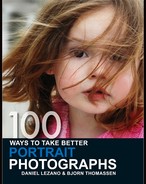63
Control light fall-off
Whether you are using daylight or studio flash to light your subject, being able to create and manipulate light fall-off is a good way of controlling where the main emphasis of the image is focused. With the lightest parts of the frame naturally drawing the eye, by determining where shadows fall it is possible to isolate the subject from the background and lead the eye to a particular point. With daylight, the easiest way to do this is to bathe the subject in directional light and then, using opaque light shields (large black polyester or cardboard sheets are most popular), to block out the light path to certain areas. This creates a strong contrast between lit areas of the subject and deep shadow. These types of light shield can also be used with studio flash. Alternatively, the flash heads can be fitted with attachments (such as barn doors or honeycombs) designed to control the direction of light.

ISOBEL
This image was taken using two studio flash heads with the direction of light carefully controlled so that the emphasis fell on the subject’s hair, face, shoulder and upper back. The light was also controlled to reveal the beautiful texture and colour of the dress, while ensuring this did not distract from the main emphasis. Two flash heads with honeycomb attachments were used. The main light was placed at 45° up and to the left of the camera so as to direct light on the face and upper torso. The second light was placed to the right of the camera at 120°. It acted as an accent light, which provided a less intense light to accentuate the body’s shape as well as providing a rimlight to the hair and right arm. A black paper backdrop ensured that no light was reflected back on to the scene.
Canon EOS-10D, 28–70mm f/2.8 lens, 1/125 sec at f/11, ISO 100.
